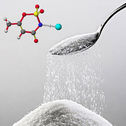
Acceptable daily intake is 15 mg/kg body weight.
 Calorie-free sugar substitute (artificial sweeetener), potassium salt of 6-methyl-1,2,3-oxathiazine-4(3H)-one 2,2-dioxide. Also known as E950, acesulfame K, Ace K, Sunett and Sweet One, Acesulfame potassium is as sweet as aspartame, 180-200 times sweeter than sucrose, half as sweet as saccharin (that also has a slightly bitter aftertaste), and only a quarter as sweet as sucralose. Acceptable daily intake is 15 mg/kg body weight.
Comments
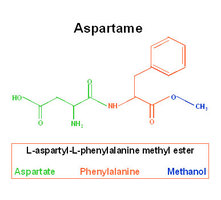 methyl ester of the aspartic acid/phenylalanine dipeptide used as a sugar substitute in some foods and beverages. Aspartame is a non-saccharide sweetener, and as a non-carbohydrate it differentiates from other sweeteners like sucrose and glucose. It is also classified as artificial and non-nutritive - as it has only 4 calories per gram. Aspartame is roughly 200 times sweeter than sucrose and is fully digested by the body, breaking down to methanol, formaldehyde, formic acid, phenylalanine and aspartic acid. In carbonated drinks, it also creates a substance called aspartylphenylalanine diketopiperazine. US FDA has set the ADI for aspartame at 50 mg/kg of body weight/day. In contrast, the European Commission’s Scientific Committee on Food (SCF) has set it at 40 mg/kg. This means that an adult should not consume more than 20 aspartame-sweetened 12oz carbonated soft drinks per day.  a very sweet (173% sweetness compared to sucrose) monosaccharide hexose sugar found especially in honey and fruit. Molecular formula: C6H12O6 Maximum ingestible capability for over 50% of humans is 25–50 g. Absorption of free fructose in the small intestine differs markedly from glucose and is primarily mediated by the GLUT5 transporter, with possible participation of GLUT2. Lactic acid bacteria (LAB), particularly the lactobacilli, represent the best characterized group of fructophilic microbes.. Other bacteria capable of metabolizing fructose are Bifidobacterium and Faecalibacterium (Clostridium cluster IV).. 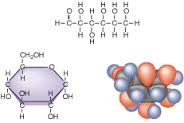 A simple monosaccharide (sugar) with a molecular formula of C6H12O6. Glucose has several forms. One form is D-glucose, also known as dextrose. The "D" refers to the arrangement of alcohol, or OH, groups on the carbon skeleton of the sugar. L-Glucose could be a low-calorie sweetener, but it does not occur in nature and is too costly to produce. Another form of glucose is beta-D-glucopyranose. As in straight chain D-glucose, the "D" refers to the arrangement of alcohol groups on the carbon skeleton. alpha-D-glucopyranose differs from beta- by the orientation of a single alcohol group around the cyclic carbon backbone. Alpha-D-glucopyranose can be found in solution, or combined with other molecules of sugar. Digestible starch is made of many hundreds of linked alpha-D-glucopyranose units. 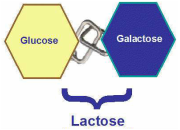 sugar comprising of one glucose molecule linked to a galactose molecule; naturally occurs in milk. Lactase enzyme, normally produced by cells that line the small intestine, splits lactose into its smaller sugars. Primary lactase deficiency (hypolactasia) occurs after weaning. It is distinguished from alactasia (total lack of lactase) that is a rare congenital defect. Secondary lactase deficiency occurs due to damage to the lining of the intestine and is generally reversible. Most lactose-intolerant people can tolerate a certain level of lactose in their diets without ill effects. Higher amounts could cause abdominal bloating, cramping, flatulence, diarrhea, nausea, borborygmi, and vomiting. Klebsiella Pneumoniae, E.coli and Enterobacter Cloacae are examples of opportunistic bacteria that live in human intestines and help to quickly digest lactose. Serratia marcescens and Citrobacter could do it too, but are slow fermenters. 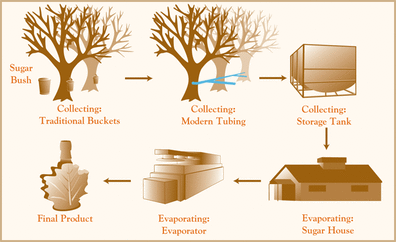 Thick sweet liquid collected from the rising sap of sugar maple trees. Maple Syrup begins as sap - the watery fluid that circulates through a a maple tree. The sap is harvested when temperatures at night are below freezing but it is above freezing in day time. The sap is then concentrated and filtered into maple syrup. Syrup produced at the beginning of the season is typically lighter in color and sweeter tasting. It is called 'light' or light amber. As the season progresses, the syrup becomes darker in color and the maple flavor becomes stronger. It first becomes medium amber, then dark amber. After dark amber it becomes 'grade b' syrup, so called because it is not top quality in color but has a strong maple flavor. The stronger the flavor, the less swweter the taste. Maple syrup contains more calcium then milk, more potassium than a banana, more manganese, iron, and zinc than honey. It has a variety of pleasantly smelling compounds such as vanillin, hydroxybutanone, propionaldehyde, maple furanone, strawberry furanone, and maltol. Maple syrup also contains antioxidants such as polyphenols including Ginnalins A-C and Quebecol. 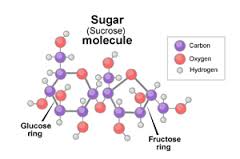 organic compound commonly known as table sugar and sometimes called Saccharose. It is a disaccharide and consists of glucose and fructose joined together. Obtained from sugar cane and sugar beets, Sucrose is more expensive than High-fructose corn syrup (HFCS) derived from corn. White refined sugar is the most common form. Brown sugar comes either from the late stages of cane sugar refining (before all of the molasses was taken out) or from coating white refined sugar with a cane molasses syrup. 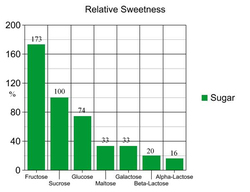
short-chain, soluble carbohydrate characterized by a sweet flavor.
There are various types of sugar derived from different sources. Simple sugars (monosaccharides) include glucose (also known as dextrose), fructose and galactose. The table or granulated sugar most customarily used as food is sucrose, a disaccharide that breaks into fructose and glucose in the body. Other disaccharides include maltose and lactose. |
Categories
All
|